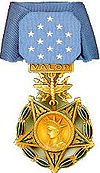Merlyn Hans Dethlefsen
Merlyn Hans Dethlefsen | |
|---|---|
96th Bombardment Wing | |
| Battles/wars | Vietnam War |
| Awards | Medal of Honor Distinguished Flying Cross Meritorious Service Medal (2) Air Medal (10) |
Merlyn Hans Dethlefsen (June 29, 1934 – December 14, 1987) was a United States Air Force officer and a recipient of the United States military's highest decoration—the Medal of Honor—for his actions in the Vietnam War.
Early life
Dethlefsen was born June 1934 in Greenville, Iowa. After attending Iowa State University for two years, he joined the Air Force from Royal, Iowa, in 1954, and was commissioned through the aviation cadet program in 1955.[1]
Military career


Dethlefsen served as a Navigator on
He flew with the 560th Tactical Fighter Squadron at McConnell Air Force Base from February 1965 to October 1966, when he deployed to Southeast Asia.
In 1965, he earned his college degree from
Vietnam and Medal of Honor Mission
On 1966, he was deployed to
On March 10, 1967, Dethlefsen refused to fly his badly damaged
Their job was to attack the surface-to-air missile complex, antiaircraft guns and a ring of automatic weapons guarding the target. On the first pass, his flight leader (F-105F 63–8335, piloted by David Everson and Jose Luna, both POW) was shot down by 85mm AAA fire and his wing man was forced to withdraw with severe damage. Dethlefsen then took command of the flight while fending off MiG attacks and responding to his own battle-damaged aircraft. As he maneuvered, he evaded an intercepting Mikoyan-Gurevich MiG-21 by flying into heavy enemy antiaircraft fire. His F-105 was severely damaged, but he determined the aircraft could still fly.
Despite his nearly crippled plane, Dethlefsen made repeated strikes with his wingman, Kenneth Bell, against the enemy's defensive positions. Evading a second MiG, Dethlefsen dove through the obscuring haze to locate the missile complex when he was again hit by flak. Making a final dive bombing attack and a strafing run with 20 mm cannon fires, Dethlefsen effectively destroyed two missile sites before finally leaving for Takhli, 500 miles away. The mission was considered a success although two F-4s of the strike force were shot down.[4]
Dethlefsen could have pulled out of the mission on a number of occasions: when attacked by MiGs, when he and his wingman were hit by flak, or when the smoke of battle made it difficult to locate the enemy. But he decided to make repeated passes, each one more dangerous than the one before. For his actions, Dethlefsen was awarded the Medal of Honor by President Lyndon B. Johnson on February 1, 1968. He became the third of 12 airmen so honored during the Vietnam War.
Post War
After his tour of duty in Vietnam, he served as an instructor pilot with the 3575th Pilot Training Squadron and 3576th Student Squadron at Vance Air Force Base, from June 1967 to August 1971.
Dethlefsen next attended
He retired from the Air Force in 1977 with the rank of colonel. Dethlefsen died at age 53 of natural causes on December 14, 1987, and was subsequently buried in Section 65 of Arlington National Cemetery.
Awards and decorations
Dethlefsen's decorations include:

| ||
| US Air Force Command Pilot Badge | |||||||||||
| Medal of Honor | Distinguished Flying Cross | Meritorious Service Medal with bronze oak leaf cluster | |||||||||
| Air Medal with one silver and three bronze oak leaf clusters | Air Medal (second ribbon required for accouterment spacing) | Air Force Commendation Medal | |||||||||
| Presidential Unit Citation | Air Force Outstanding Unit Award with four bronze oak leaf clusters
|
Air Force Reserve Good Conduct Medal | |||||||||
| Combat Readiness Medal | National Defense Service Medal with bronze service star | Armed Forces Expeditionary Medal | |||||||||
campaign stars
|
Air Force Longevity Service Award with four bronze oak leaf clusters
|
Armed Forces Reserve Medal | |||||||||
Small Arms Expert Marksmanship Ribbon
|
Republic of Vietnam Gallantry Cross
|
Vietnam Campaign Medal | |||||||||
Medal of Honor citation

Maj. Dethlefsen was 1 of a
fighter bombers immediately after the strike by Maj. Dethlefsen's flight. In the initial attack on the defensive complex the lead aircraft was crippled, and Maj. Dethlefsen's aircraft was extensively damaged by the intense enemy fire. Realizing that the success of the impending fighter bomber attack on the center now depended on his ability to effectively suppress the defensive fire, Maj. Dethlefsen ignored the enemy's overwhelming firepower and the damage to his aircraft and pressed his attack. Despite a continuing hail of antiaircraft fire, deadly surface-to-air missiles, and counterattacks by MIG interceptors, Maj. Dethlefsen flew repeated close range strikes to silence the enemy defensive positions with bombs and cannon fire. His action in rendering ineffective the defensive SAM and antiaircraft artillery sites enabled the ensuing fighter bombers to strike successfully the important industrial target without loss or damage to their aircraft, thereby appreciably reducing the enemy's ability to provide essential war material. Maj. Dethlefsen's consummate skill and selfless dedication to this significant mission were in keeping with the highest traditions of the U.S. Air Force and reflect great credit upon himself and the Armed Forces of his country.[5]
In popular culture
- In episode 298 of The Simpsons, "Special Edna", Bart Simpson's classmate Nelson Muntz makes a subtle reference to Dethlefsen's service in the Vietnam War:
Edna Krabappel: "The topic for your research paper is World War I."
Bart: "Was that the one with Hitler, or the one with Merlin?"
Nelson: "You idiot! Merlyn was in Vietnam!"
See also
References
- ^ "Shadow box". airforce.togetherweserved.com.
- ^ Iowa Medal of Honor Heroes.
- ^ a b "Veteran Tributes". www.veterantributes.org.
- ^ Chris Hobson, Vietnam Air Losses, Midland Publishing, 2001
- ^ "Medal of Honor recipients – Vietnam (A-L)". United States Army Center of Military History. August 3, 2009. Archived from the original on 2009-06-27. Retrieved 2009-09-21.
